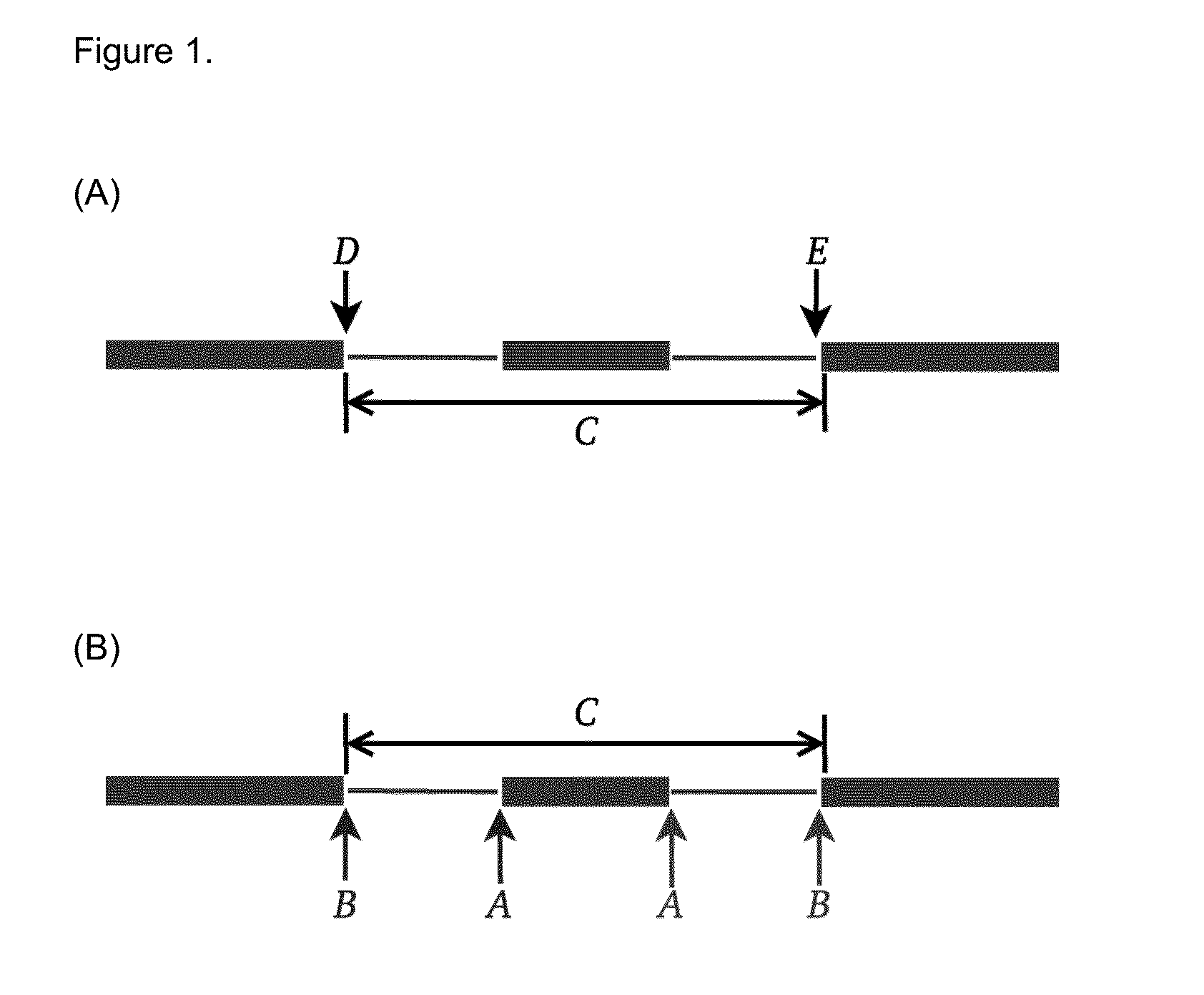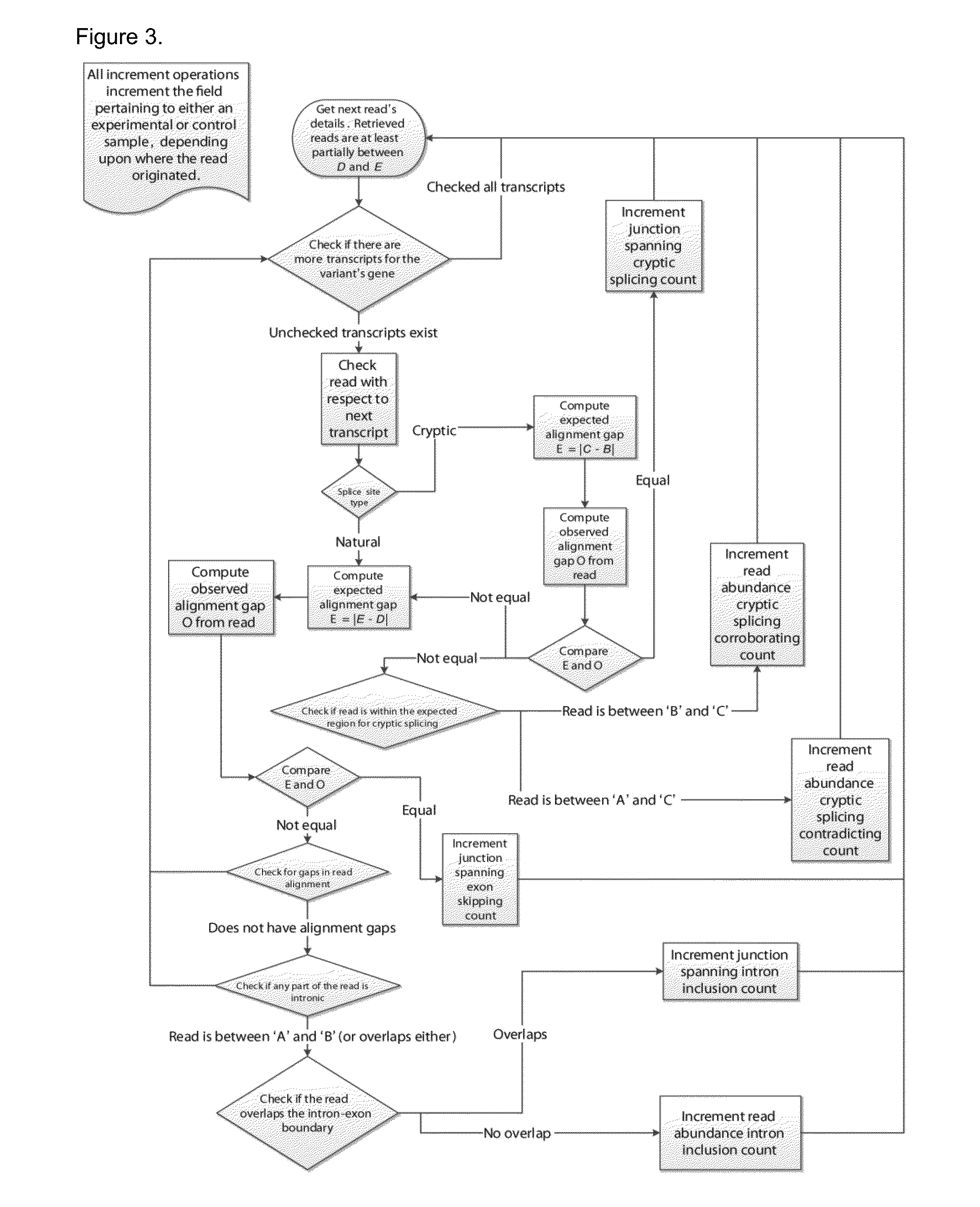Method of Validating mRNA Splciing Mutations in Complete Transcriptomes
a transcriptome and transcript technology, applied in the field of validation of mrna splciing mutations in complete transcriptomes, can solve the problems of not taking into account the impact of mutations, cannot be used to analyze the relative abundance of different isoforms, and cannot be used in prior art computations that do not make reference to, incorporate, or anticipate exon recognition processes, etc., to accurately detect conventional alternative splice isoforms, the effect of loss of statistical significan
- Summary
- Abstract
- Description
- Claims
- Application Information
AI Technical Summary
Benefits of technology
Problems solved by technology
Method used
Image
Examples
example 1
Leaky Splicing Mutations
[0068]Mutations that reduce, but not abolish, the spliceosome's ability to recognize the intron / exon boundary are termed leaky3. This can lead to the mis-splicing (intron inclusion and / or exon skipping) of many but not all transcripts. An example, provided in FIG. 4, displays a predicted leaky mutation (chr5:162905690G>T) in the HMMR gene in which both junction-spanning exon skipping (pi exceeds 1.6 bits—the minimal individual information required to recognize a splice site and produce correctly spliced mRNA (Rogan et al. 2003). Indeed, the natural site, while weakened by 2.16 bits, remains strong—10.67 bits. This prediction is validated by the variant-containing sample's RNA-Seq data (FIG. 4), in which both exon skipping (5 reads) and intron inclusion (14 reads, 12 of which are shown, versus an average of 4.051 such reads per control sample) are observed, along with 70 reads portraying wild-type splicing. Only a single normally spliced read contains the G→T ...
example 2
Splice Site Inactivating Mutations
[0069]Variants that inactivate splice sites have negative final Ri values (Rogan et al. 1998) with only rare exceptions (Rogan et al. 2003), indicating that splice site recognition is essentially abolished in these cases. We present the analysis of two inactivating mutations within the PTEN and TMTC2 genes from different tumour exomes, namely: chr10:89711873A>G and chr12:83359523G>A, respectively. The PTEN variant displays junction-spanning exon skipping events (pT) within the AGRN gene. The concordance between the splicing outcomes generated by these mutations and the Veridical results indicates that the proposed method detects both mutations that inactivate splice sites and cryptic splice site activation.
example 3
Cryptic Splicing Mutations
[0070]Recurrent genetic mutations in some oncogenes have been reported among tumours within the same, or different, tissues of origin. Common recurrent mutations present in multiple abnormal samples are recognized by Veridical. This avoids including a variant-containing sample among the control group, and outputs the results of all of the variant-containing samples. A relevant example is shown in FIG. 7. The mutation (chr1:46726876G>T) causes activation of a cryptic splice site within RAD54L in multiple tumours. Upon computation of the p-values for each of the variant-containing tumours, relative to all non-variant containing tumours and normal controls, not all variant-containing tumours displayed splicing abnormalities at statistically significant levels. Of the six variant-containing tumours, two had significant levels of junction-spanning intron inclusion, and one showed statistically significant read-abundance-based intron inclusion.
PUM
| Property | Measurement | Unit |
|---|---|---|
| Ri | aaaaa | aaaaa |
| structure | aaaaa | aaaaa |
| çe | aaaaa | aaaaa |
Abstract
Description
Claims
Application Information
 Login to View More
Login to View More - R&D
- Intellectual Property
- Life Sciences
- Materials
- Tech Scout
- Unparalleled Data Quality
- Higher Quality Content
- 60% Fewer Hallucinations
Browse by: Latest US Patents, China's latest patents, Technical Efficacy Thesaurus, Application Domain, Technology Topic, Popular Technical Reports.
© 2025 PatSnap. All rights reserved.Legal|Privacy policy|Modern Slavery Act Transparency Statement|Sitemap|About US| Contact US: help@patsnap.com



